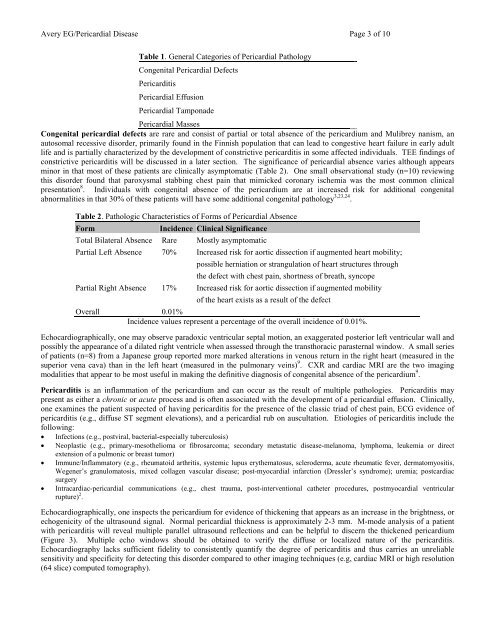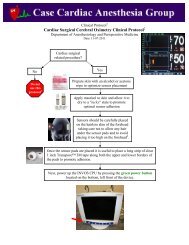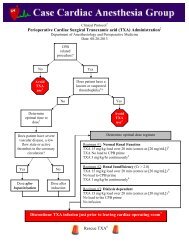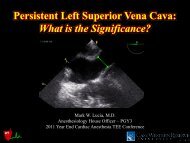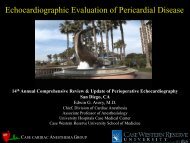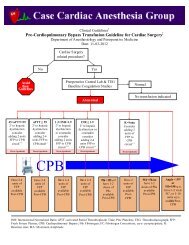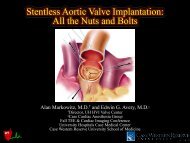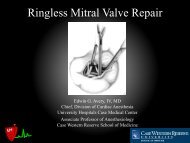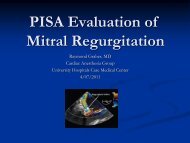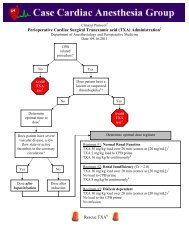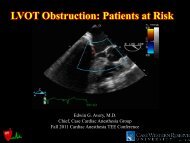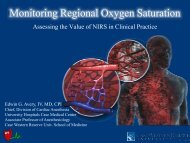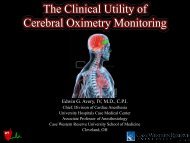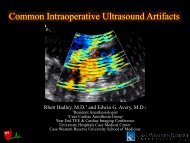Echocardiographic Evaluation of Pericardial Disease - Casecag.com
Echocardiographic Evaluation of Pericardial Disease - Casecag.com
Echocardiographic Evaluation of Pericardial Disease - Casecag.com
Create successful ePaper yourself
Turn your PDF publications into a flip-book with our unique Google optimized e-Paper software.
Avery EG/<strong>Pericardial</strong> <strong>Disease</strong> Page 3 <strong>of</strong> 10Table 1. General Categories <strong>of</strong> <strong>Pericardial</strong> PathologyCongenital <strong>Pericardial</strong> DefectsPericarditis<strong>Pericardial</strong> Effusion<strong>Pericardial</strong> Tamponade<strong>Pericardial</strong> MassesCongenital pericardial defects are rare and consist <strong>of</strong> partial or total absence <strong>of</strong> the pericardium and Mulibrey nanism, anautosomal recessive disorder, primarily found in the Finnish population that can lead to congestive heart failure in early adultlife and is partially characterized by the development <strong>of</strong> constrictive pericarditis in some affected individuals. TEE findings <strong>of</strong>constrictive pericarditis will be discussed in a later section. The significance <strong>of</strong> pericardial absence varies although appearsminor in that most <strong>of</strong> these patients are clinically asymptomatic (Table 2). One small observational study (n=10) reviewingthis disorder found that paroxysmal stabbing chest pain that mimicked coronary ischemia was the most <strong>com</strong>mon clinicalpresentation 8 . Individuals with congenital absence <strong>of</strong> the pericardium are at increased risk for additional congenitalabnormalities in that 30% <strong>of</strong> these patients will have some additional congenital pathology 3,23,24 .Table 2. Pathologic Characteristics <strong>of</strong> Forms <strong>of</strong> <strong>Pericardial</strong> AbsenceFormIncidence Clinical SignificanceTotal Bilateral Absence Rare Mostly asymptomaticPartial Left Absence 70% Increased risk for aortic dissection if augmented heart mobility;possible herniation or strangulation <strong>of</strong> heart structures throughthe defect with chest pain, shortness <strong>of</strong> breath, syncopePartial Right Absence 17% Increased risk for aortic dissection if augmented mobility<strong>of</strong> the heart exists as a result <strong>of</strong> the defectOverall 0.01%Incidence values represent a percentage <strong>of</strong> the overall incidence <strong>of</strong> 0.01%.<strong>Echocardiographic</strong>ally, one may observe paradoxic ventricular septal motion, an exaggerated posterior left ventricular wall andpossibly the appearance <strong>of</strong> a dilated right ventricle when assessed through the transthoracic parasternal window. A small series<strong>of</strong> patients (n=8) from a Japanese group reported more marked alterations in venous return in the right heart (measured in thesuperior vena cava) than in the left heart (measured in the pulmonary veins) 9 . CXR and cardiac MRI are the two imagingmodalities that appear to be most useful in making the definitive diagnosis <strong>of</strong> congenital absence <strong>of</strong> the pericardium 9 .Pericarditis is an inflammation <strong>of</strong> the pericardium and can occur as the result <strong>of</strong> multiple pathologies. Pericarditis maypresent as either a chronic or acute process and is <strong>of</strong>ten associated with the development <strong>of</strong> a pericardial effusion. Clinically,one examines the patient suspected <strong>of</strong> having pericarditis for the presence <strong>of</strong> the classic triad <strong>of</strong> chest pain, ECG evidence <strong>of</strong>pericarditis (e.g., diffuse ST segment elevations), and a pericardial rub on auscultation. Etiologies <strong>of</strong> pericarditis include thefollowing:• Infections (e.g., postviral, bacterial-especially tuberculosis)• Neoplastic (e.g., primary-mesothelioma or fibrosar<strong>com</strong>a; secondary metastatic disease-melanoma, lymphoma, leukemia or directextension <strong>of</strong> a pulmonic or breast tumor)• Immune/Inflammatory (e.g., rheumatoid arthritis, systemic lupus erythematosus, scleroderma, acute rheumatic fever, dermatomyositis,Wegener’s granulomatosis, mixed collagen vascular disease; post-myocardial infarction (Dressler’s syndrome); uremia; postcardiacsurgery• Intracardiac-pericardial <strong>com</strong>munications (e.g., chest trauma, post-interventional catheter procedures, postmyocardial ventricularrupture) 2 .<strong>Echocardiographic</strong>ally, one inspects the pericardium for evidence <strong>of</strong> thickening that appears as an increase in the brightness, orechogenicity <strong>of</strong> the ultrasound signal. Normal pericardial thickness is approximately 2-3 mm. M-mode analysis <strong>of</strong> a patientwith pericarditis will reveal multiple parallel ultrasound reflections and can be helpful to discern the thickened pericardium(Figure 3). Multiple echo windows should be obtained to verify the diffuse or localized nature <strong>of</strong> the pericarditis.Echocardiography lacks sufficient fidelity to consistently quantify the degree <strong>of</strong> pericarditis and thus carries an unreliablesensitivity and specificity for detecting this disorder <strong>com</strong>pared to other imaging techniques (e.g, cardiac MRI or high resolution(64 slice) <strong>com</strong>puted tomography).


